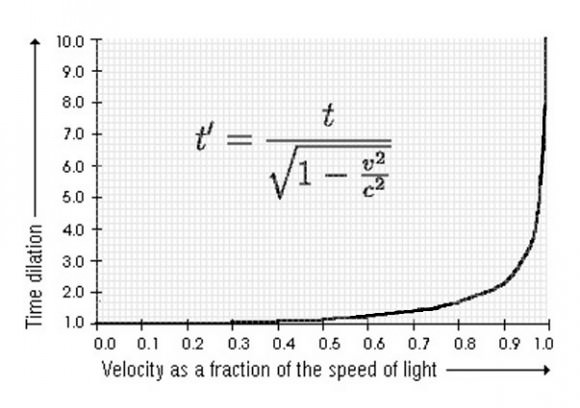In a previous article, I talked about how you can generate artificial gravity by accelerating at 9.8 meters per second squared. Do that and you pretty much hit the speed of light, then you decelerate at 1G and you’ve completed an epic journey while enjoying comfortable gravity on board at the same time. It’s a total win win.
What I didn’t mention how this acceleration messes up time for you and people who aren’t traveling with you. Here’s the good news. If you accelerate at that pace for years, you can travel across billions of light years within a human lifetime.
Here’s the bad news, while you might experience a few decades of travel, the rest of the Universe will experience billions of years. The Sun you left will have died out billions of years ago when you arrive at your destination.
Welcome to the mind bending implications of constantly accelerating relativistic spaceflight.
With many things in physics, we owe our understanding of relativistic travel to Einstein. Say it with me, “thanks Einstein.”

It works like this. The speed of light is always constant, no matter how fast you’re going. If I’m standing still and shine a flashlight, I see light speed away from me at 300,000 km/s. And if you’re traveling at 99% the speed of light and shine a flashlight, you’ll see light moving away at 300,000 km/s.
But from my perspective, standing still, you look as if you’re moving incredibly slowly. And from your nearly light-speed perspective, I also appear to be moving incredibly slowly – it’s all relative. Whatever it takes to make sure that light is always moving at, well, the speed of light.
This is time dilation, and you’re actually experiencing it all the time, when you drive in cars or fly in an airplane. The amount of time that elapses for you is different for other people depending on your velocity. That amount is so minute that you’ll never notice it, but if you’re traveling at close to the speed of light, the differences add up pretty quickly.
But it gets even more interesting than this. If you could somehow build a rocket capable of accelerating at 9.8 meters/second squared, and just went faster and faster, you’d hit the speed of light in about a year or so, but from your perspective, you could just keep on accelerating. And the longer you accelerate, the further you get, and the more time that the rest of the Universe experiences.
The really strange consequence, though, is that from your perspective, thanks to relativity, flight times are compressed.
I’m using the relativistic star ship calculator at convertalot.com. You should give it a try too.

For starters, let’s fly to the nearest star, 4.3 light-years away. I accelerate halfway at a nice comfortable 1G, then turn around and decelerate at 1G. It only felt like 3.5 years for me, but back on Earth, everyone experienced almost 6 years. At the fastest point, I was going about 95% the speed of light.
Let’s scale this up and travel to the center of the Milky Way, located about 28,000 light-years away. From my perspective, only 20 years have passed by. But back on Earth, 28,000 years have gone by. At the fastest point, I was going 99.9999998 the speed of light.
Let’s go further, how about to the Andromeda Galaxy, located 2.5 million light-years away. The trip only takes me 33 years to accelerate and decelerate, while Earth experienced 2.5 million years. See how this works?

I promised I’d blow your mind, and here it is. If you wanted to travel at a constant 1G acceleration and then deceleration to the very edge of the observable Universe. That’s a distance of 13.8 billion light-years away; you would only experience a total of 45 years. Of course, once you got there, you’d have a very different observable Universe, and billions of years of expansion and dark energy would have pushed the galaxies much further away from you.
Some galaxies will have fallen over the cosmic horizon, where no amount of time would ever let you reach them.
If you wanted to travel 100 trillion light years away, you could make the journey in 62 years. By the time you arrived, the Universe would be vastly different. Most of the stars would have died a long time ago, the Universe would be out of usable hydrogen. You would have have left a living thriving Universe trillions of years in the past. And you could never get back.
Our good friends over at Kurzgesagt covered a very similar topic, discussing the limits of humanity’s exploration of the Universe. It’s wonderful and you should watch it right now.
Of course, creating a spacecraft capable of constant 1G acceleration requires energies we can’t even imagine, and will probably never acquire. And even if you did it, the Universe you enjoy would be a distant memory. So don’t get too excited about fast forwarding yourself trillions of years into the future.


With all due respect, Fraser, the average human lifetime (worldwide average) is only about 71 years, so the greatest distance one could travel while going at the speed of light for the duration of a human lifetime would be only about 71 light years, not billions of light years. Individual human beings do not live for billions of years, so they could not possibly travel for billions of light years while going at the speed of light.
You are correct. This article is science fiction, not science.
This is real: predicted by Einstien, proven by satellite data.
You may have mistaken the point here. If you were to travel at near light speed, time for you in the ship would go much slower than time outside the ship. So, 71 years inside the ship would equate to the billions of years as described in the article. You’ve confused the time inside the ship for that outside the ship. If someone on Earth were to live 71 years, another in a ship traveling at near light speed would only experience a small fraction of that time. So in your ship going to Alpha Centuri and returning home at near light speed, those on Earth would have died because much more time has passed here on Earth.
Generational ships? Cryogenics? Both more plausible than unlimited 1G acceleration.
Except that time dilation means that for those traveling at close to c, time would slow to nearly nothing. They may traverse only traverse 71 light years of space, but to the outside universe, eons would have passed.
You are both correct, and incorrect – it all depends on your point of reference. While Fraser has wondered off into a bit of wooley thinking, you have failed to specify your point of reference. For a person on Earth, the person traveling at 20%C will indeed only travel a bit over 17light yrs. For the person on the space craft, because of time dilation, they will travel much further. It has nothing to do with “Time Travel” but solely with the point of reference from which the measurements are made.
Reach C and the Universe ends. Talk about a speed limit!
Well, how fortunate for us all, then, that it is totally and utterly impossible to reach c!
Doing this, given special relativity, would be exactly like reaching infinite speed in Newtonian mechanics — not only can you not reach it; nothing you do will get you any closer to it.
Traveling at 0.999999999c is no closer to light speed than being at rest, because to you, light is still going the exact same 299,792,458 m/s faster than you are.
And in any case, those speeds are relative to some single inertial frame; relative to some other inertial frame, your speed is something else. And whether in Newtonian or Einsteinian physics, any inertial frame is as valid as any other for describing and calculating motion.
What would streaming video look like to two different travelers? Let’s say John and Jane are friends who start streaming a video to each other. They’re each watching the others video. Jane gets into a spaceship and starts accelerating at some appreciable acceleration in her spaceship. What do the two video’s look like? For John who sees Jane’s time traveling more slowly, It’s not going to look like slow motion if for no other reason that when the image was recorded it wasn’t in slow motion. And will Jane receive more frames per second than John is sending?
What would streaming video look like to two different travelers? Let’s say John and Jane are friends who start streaming a video to each other. They’re each watching the others video. Jane gets into a spaceship and starts accelerating at some appreciable acceleration in her spaceship. What do the two video’s look like? For John who sees Jane’s time traveling more slowly, It’s not going to look like slow motion if for no other reason that when the image was recorded it wasn’t in slow motion. And will Jane receive more frames per second than John is sending?
@Redbird: IRL, the signal gets stretched in both directions due to the acceleration of Jane’s spacecraft. It’s possible that the videos could both play at the correct speed, but only if both ends are buffered sufficiently! This is a hurdle for satellite communications here on Earth: comm sats move pretty quickly in a different gravitational field relative to the surface stations they talk to, so the frequencies/data rates of their signals often get stretched/squished due to relativistic & Doppler effects. SATCOM equipment has to account for this or data rates above ~Kbps aren’t really possible.
But in addition to the pretty black hole, “Interstellar” got this bit essentially right as well: great speed/gravity will slow one’s local clock (in this case Jane’s) with respect to the rest of the universe (in this case, John’s). The movie astronauts didn’t notice it themselves but time passed much faster on Earth than it did for them, becoming a big plot point in the process.
So if we want to say that their hypothetical technology allows them to see each other in real time for the sake of illustration, then the video of Jane will appear to slow down for John while the video of John will appear to speed up for Jane as her spacecraft accelerates; Jane will receive more video frames because John will be sending them faster than Jane in both of their frames of reference.
It doesn’t work like that. When you travel very fast, both the passage of time and space change for you. So when you are going close to the speed of light and you look out the window, you see that your destination to be much closer. Space squishes together in the direction you are traveling- so to you, you did not travel as far as stationary observers saw you travel. Entire galaxies won’t be light years across to you. Space and time are connected and change with each other- it’s impossible for one to change without the other changing too.
@PhysicsCat: Yes, not only does time dilate but space as well, just as you point out.
Over on the YewTewbz, the MinutePhysics channel has a great video explaining how this dilation of space (and thus the apparent size of the moving electrons) is exactly the reason why electro-magnets work when the power is on, but stop working when the power is shut off. The dilation of time Fraser talks about here is just the same effect, only using chronographs instead of rulers.
Its because time is just one dimension of space-time. When you travel in space at speed near to c, you cant travel in time as someone that stands still.
Matko, that is an excellent way of describing it.